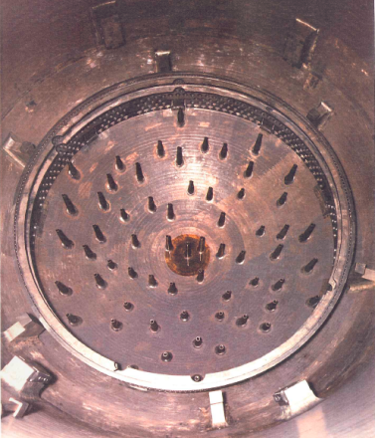
It makes sinking a half-court shot in basketball look easy. To ensure that pressurized water reactors in certain nuclear power plants are functioning properly, it’s necessary to insert an ultrasonic inspection device through three-quarter-inch nozzles on the reactor vessel’s bottom head (known as bottom-mounted instrumentation nozzles).
There’s little room for error. The technician must remotely guide a robotic arm from the top of the reactor to the bottom of a 110-foot-deep cooling water pool surrounding the reactor. Video transmitted from the delivery tool inside the reactor helps guide the technician through the task. “It takes the skilled hand of an operator to get the probes where they need to go,” said EPRI Principal Project Manager Robert Grizzi. “It’s like threading a very tiny needle.” Nuclear plant operators conduct this comprehensive nozzle inspection when initial visual exams reveal potential areas of concern.
A Mock-up to Test the Inspector
This job cannot be done by just anyone. It is standard practice for nuclear utilities to hire specialized vendors to complete the inspection procedures, which are governed by federal regulations and American Society of Mechanical Engineers (ASME) codes and standards.
In 2013, Arizona Public Service (APS) asked EPRI to help ensure that the vendor it selected for comprehensive nozzle inspections at its Palo Verde Unit 3 nuclear plant could do the work properly. “The vendor needed to demonstrate that its inspection technique works and follows standards and federal requirements,” said Grizzi.
To assess the vendor’s effectiveness, EPRI built a full-scale replica of a bottom-mounted instrumentation nozzle at Palo Verde Unit 3, incorporating cracks and other defects in it. The vendor successfully inspected the mock-up in accordance with standards and regulations, locating all the cracks.
By qualifying the vendor, the demonstration enabled APS to decide to move forward with its inspection. It also helped the utility prepare for future inspections, avoiding extended outages.
“If APS didn’t have the vendor, equipment, and processes ready for the comprehensive inspection, it could have taken five to six months to find and qualify the vendor,” said Grizzi. “The plant can’t go online until all that is in place.”
Ready for Application to Other Plants
Given Palo Verde’s unique reactor designs, the results of the EPRI-APS collaboration are not directly transferable to other nuclear plant operators. Nevertheless, the mock-up methods and experience equip EPRI to construct and test customized mock-ups for other plants. “There will eventually be follow-up work,” said Grizzi. “When we have the opportunity to apply the same methods, it can enable as positive an impact for other utilities as it did for APS.”
EPRI Technical Experts:
Robert Grizzi, Leif Esp


